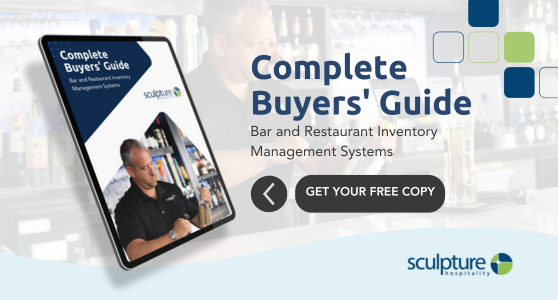Inventory control is a key component of managing a successful bar. It ensures service runs smoothly, reduces waste, improves forecasting and purchasing, and increases the bottom line.
Without a properly managed inventory, you could find yourself dealing with stock shortages, upset customers, unsellable products and more.
To help you on your way to a well-managed bar inventory and, ultimately, greater success, we’ve created a bar inventory checklist of everything you need for success:
- Organize your stock
Before you can start successful inventory management on your liquor inventory, you need to make sure it is well organized. This will help you keep better track of your products and make sure nothing is missed or miscounted. To help keep your stock organization, implement these best practices:
- Have a specific space for storing alcohol (i.e. avoid using the space to store other items like toilet paper, spare cutlery, etc.)
- Group like items – this can be as simple as organizing by type of alcohol (i.e. beer, wine, liquor, liqueur) or as complex as organizing wines by region, beers by domestic or imported, etc.
- Label shelves and bins
- Train staff to store products correctly
- Have an inventory team
While inventory can be done by one person, this is not recommended. If only one person is completing inventory, there will be a lack of accountability, increased risk of errors and even the potential for internal theft.
Always make sure you have two or three people doing inventory in rotation, either alone or in pairs.
- Choose two or three staff members for your inventory team – they will be responsible for receiving orders, updating records and taking counts
- Train staff on proper inventory management procedures
- Create an inventory counting schedule
- Track the right information
There are many different ways to track bar inventory from pen and paper to spreadsheet, but there’s no doubt that the use of a bar inventory management system is the best option.
However, whichever you choose, ensure you are collecting the right information, so you have proper oversight and data for strategic decision making. Here are some of the information you should be collecting:
- Ingredient name
- Unit of measure
- Beginning inventory
- Amount used
- Ending inventory
- Quantity wasted
- Waste cost
- Expiry
- Location
- Manage your waste
You may have noticed in the last section that we mention quantity wasted and the cost of that waste as important information to track.
Waste has a huge impact on your profitability. If you aren’t keeping track of how much is being wasted, you will not know how much it is affecting your business, whether you're improving, or why it keeps happening. Visibility into your beverage waste will also create accountability and reduce the risk of employee theft.
To help reduce waste, and in turn increase your bottom line, consider these steps:
- Start a waste journal - Whenever there is a spill or repour, make sure staff are recording (i.e. have them write it down or enter it in the system)
- Complete regular inventories – When maintaining an alcohol inventory, you will want to do daily or weekly inventories depending on how quickly products move in and out of your restaurant
- Create policies – To ensure that your team is doing everything they can to reduce waste, you should establish policies and procedures, as well as train staff. This includes
- Don’t over buy - While unopened alcohol won’t expire within a month or two, ordering smaller batches protects you from unexpected changes in demand. It also means that your capital won’t be sitting on your shelves instead of in your bank.
- Wine & Liquor – order once a month
- Beer in cans and bottles – order two to three times a month
- Draft beer – order one to two times a month
- Store alcohol correctly
- Don’t expose it to too much light
- Reduce exposure to air
- Avoid temperature extremes
- Store bottle the right way (i.e. wine on side, liquor and beer upright)
- Empty fuller bottles last - the less liquid there is in the bottle, the more room there is for oxygen, which can lead to premature oxidation
- Use PAR Levels
Par level is the minimum amount of product your establishment needs to have on hand to serve customer demand until more inventory is delivered. This will help prevent your team from having to 86 items, while maximizing profits and increasing cash flow.
- Calculate par levels for each product
Par Level = (Average Inventory Used Each Week + Safety Stock) / # of Deliveries Each Week
- Update par levels regularly to reflect changes in demand
- Invest in an inventory management software that can use historical data and forecasting to automate these calculations
Interested in learning how Sculpture can help you with all of the above and implement a highly-strategic inventory management plan that makes your business more profitable? Get in touch with our team of inventory experts today.





.png)





